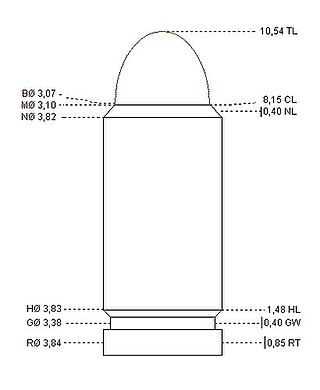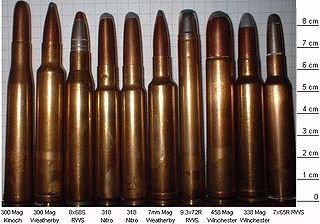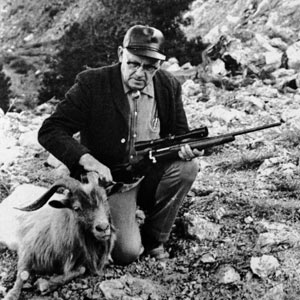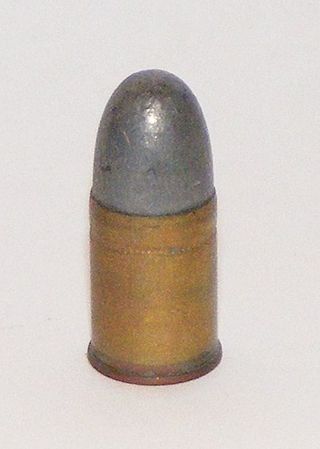Related Research Articles

In guns, particularly firearms, but not artillery, where a different definition may apply, caliber is the specified nominal internal diameter of the gun barrel bore – regardless of how or where the bore is measured and whether the finished bore matches that specification. It is measured in inches or in millimeters. In the United States it is expressed in hundredths of an inch; in the United Kingdom in thousandths; and elsewhere in millimeters. For example, a US "45 caliber" firearm has a barrel diameter of roughly 0.45 inches (11.43mm). Barrel diameters can also be expressed using metric dimensions. For example, a "9 mm pistol" has a barrel diameter of about 9 millimeters. Since metric and US customary units do not convert evenly at this scale, metric conversions of caliber measured in decimal inches are typically approximations of the precise specifications in non-metric units, and vice versa.

This is a list of firearm cartridges which have bullets in the 11 millimetres (0.43 in) to 11.99 millimetres (0.472 in) caliber range.

This is a list of firearm cartridges which have bullets in the 7.00 to 7.99 millimetres caliber range.

This is a list of firearm cartridges which have bullets in the 12 millimetres (0.47 in) to 12.99 millimetres (0.511 in) caliber range.

This is a list of firearm cartridges which have bullets in the 5.00 to 5.99 mm caliber range.

The .32 S&W cartridge was introduced in 1878 for Smith & Wesson pocket revolvers. It was originally designed as a black powder cartridge. The .32 S&W was offered to the public as a light defense cartridge for "card table" distances.

This is a list of firearm cartridges which have bullets in the 3 millimetres (0.12 in) to 3.99 millimetres (0.157 in) caliber range.

The .458 Winchester Magnum is a belted, straight-taper cased, Big Five game rifle cartridge. It was introduced commercially in 1956 by Winchester and first chambered in the Winchester Model 70 African rifle. It was designed to compete against the .450 Nitro Express and the .470 Nitro Express cartridges used in big bore British double rifles. The .458 Winchester Magnum remains one of the most popular large game cartridges, and most major ammunition manufacturers offer a selection of .458 ammunition.

The .416 Remington Magnum is a .416 caliber (10.57 mm) cartridge of belted bottlenecked design. The cartridge was intended as a dangerous game hunting cartridge and released to the public in 1989. The cartridge uses the case of the 8 mm Remington Magnum as a parent cartridge. When the cartridge was released in 1988, author Frank C. Barnes considered the .416 Remington Magnum to be the "most outstanding factory cartridge introduced in decades".

Parker Otto Ackley was an American gunsmith, barrel maker, author, columnist, and wildcat cartridge developer. The Ackley Improved family of wildcat cartridges are designed to be easily made by rechambering existing firearms, and fireforming the ammunition to decrease body taper and increase shoulder angle, resulting in a higher case capacity. Ackley improved not only standard cartridges, but also other popular wildcats, and was the first to create a .17 caliber (4.5 mm) centerfire cartridge.

The .375 Weatherby Magnum (9.5×73mmB) is a medium-bore rifle cartridge. The cartridge is blown out, improved and provided with the Weatherby double radius shoulder – given the Weatherby treatment – version of the .375 H&H Magnum. Unlike other improved versions of the .375 H&H Magnum like the .375 Ackley Improved, the .375 Weatherby Magnum is not a wildcat and existed as a proprietary cartridge until the CIP published specifications for the cartridge.

The .22 Spitfire is an American wildcat rifle cartridge developed by Col. Melvin M. Johnson. It was originally named the MMJ 5.7mm by its designer and is also known in the U.S. as the 5.7mm Johnson, the Johnson MMJ 5.7mm Spitfire, and the .22 Johnson,.

The .458 Lott is a .458 caliber rifle cartridge designed for the purpose of hunting large, thick-skinned dangerous game animals in Africa. It is based on the full length .375 H&H Magnum case blown out and shortened to 2.800 inches (71.1 mm).

The .44 S&W American / 11x23mmR is an American centerfire revolver cartridge.

The .450 Adams was a British black powder centrefire revolver cartridge, initially used in converted Beaumont–Adams revolvers, in the late 1860s. Officially designated .450 Boxer Mk I, and also known variously as the .450 Revolver, .450 Colt, .450 Short, .450 Corto, and .450 Mark III, and in America as the .45 Webley, it was the British Army's first centrefire revolver round.

Cartridges of the World is a comprehensive guide to firearm cartridges. The reference series is written by Frank C. Barnes. The latest version of the book is its 17th edition, published in 2022, and edited by W. Todd Woodard.

The .458×2-inch American is a belted, straight, .458 caliber (11.6 mm) big-bore cartridge designed by Frank Barnes. It is based on the .458 Winchester Magnum shortened to 2 in (51 mm).

The .38 rimfire / 9.5x22mmRF refers to a family of cartridges that have been in service in the United States since the mid-19th century. The cartridges are produced in short, long, and extra long variants.
.46 rimfire / 11.6x21mmRF is a family of rimfire cartridges which were chambered in revolvers and rifles in the late 19th and early 20th centuries. They were primarily made in short, long and extra long lengths; however, a variety of other lengths were designed. Manufacturers in the USA discontinued making .46 Short and .46 Long ammunition after the country's entrance into World War I in 1917; however, production of .46 Extra Long / 11.6x39mmRF continued after the war.
References
- ↑ Barnes, Frank C. (2006) [1965]. Skinner, Stan (ed.). Cartridges of the World (11th ed.). Iola, WI, USA: Gun Digest Books. p. 552. ISBN 0-89689-297-2.
- ↑ Data viewed in scans of originals (birth certificate, death certificate), family documents of Frank Charles Barnes, ancestors.familysearch.org, accessed March 20, 2021